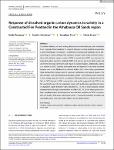Response of dissolved organic carbon dynamics to salinity in a Constructed Fen Peatland in the Athabasca Oil Sands region
| dc.contributor.author | Prystupa, E | |
| dc.contributor.author | Davidson, SJ | |
| dc.contributor.author | Price, J | |
| dc.contributor.author | Strack, M | |
| dc.date.accessioned | 2023-04-24T13:42:23Z | |
| dc.date.available | 2023-04-24T13:42:23Z | |
| dc.date.issued | 2023-03-05 | |
| dc.identifier.issn | 0885-6087 | |
| dc.identifier.issn | 1099-1085 | |
| dc.identifier.other | ARTN e14852 | |
| dc.identifier.uri | https://pearl.plymouth.ac.uk/handle/10026.1/20754 | |
| dc.description.abstract |
In northern Alberta, oil sands mining disturbs the boreal landscape, and reclamation to an ‘equivalent land capability’ is required. Industry is testing peatland construction as part of landscape reclamation. To determine if constructed peatlands can be self-sustaining, an understanding of the cycling of solutes in pore water and their interactions with dissolved organic carbon (DOC) is needed since DOC can represent an important carbon loss from peatlands. DOC is of interest due to its biotic origin and use by the microbial community and impact on carbon budgets. Additionally, salinity as a control on DOC quantity and quality may be important in oil sands reclaimed systems due to the likelihood of elevated sodium (Na+) from saline groundwater input derived from tailings used to construct catchments, and natural sources. For this research, DOC concentration and quality, and Na+ concentration were measured in the rooting zone (10 and 30 cm depth) of Nikanotee Fen to evaluate the role of Na+ in DOC dynamics. DOC concentration and quality suggested that DOC in the fen was largely sourced from vegetation inputs, with quality also suggesting increases in vegetation inputs between years. Elevated Na+ at 30 cm below ground surface corresponded with high concentrations of labile DOC. At 10 cm below ground surface, sampling location and temperature were the best predictors of DOC concentration and quality. With expected increases in Na+, increased production of mobile and microbially active DOC may lead to higher rates of carbon export. | |
| dc.language | en | |
| dc.publisher | Wiley | |
| dc.subject | dissolved organic carbon | |
| dc.subject | peatland | |
| dc.subject | reclamation | |
| dc.subject | sodium | |
| dc.subject | spectrophotometric indices | |
| dc.subject | sulphate | |
| dc.subject | water table | |
| dc.title | Response of dissolved organic carbon dynamics to salinity in a Constructed Fen Peatland in the Athabasca Oil Sands region | |
| dc.type | journal-article | |
| dc.type | Article | |
| plymouth.author-url | https://www.webofscience.com/api/gateway?GWVersion=2&SrcApp=PARTNER_APP&SrcAuth=LinksAMR&KeyUT=WOS:000960869200001&DestLinkType=FullRecord&DestApp=ALL_WOS&UsrCustomerID=11bb513d99f797142bcfeffcc58ea008 | |
| plymouth.issue | 4 | |
| plymouth.volume | 37 | |
| plymouth.publication-status | Published | |
| plymouth.journal | Hydrological Processes | |
| dc.identifier.doi | 10.1002/hyp.14852 | |
| plymouth.organisational-group | |Plymouth | |
| plymouth.organisational-group | |Plymouth|Faculty of Science and Engineering | |
| plymouth.organisational-group | |Plymouth|Faculty of Science and Engineering|School of Geography, Earth and Environmental Sciences | |
| plymouth.organisational-group | |Plymouth|REF 2021 Researchers by UoA | |
| plymouth.organisational-group | |Plymouth|Users by role | |
| plymouth.organisational-group | |Plymouth|Users by role|Academics | |
| plymouth.organisational-group | |Plymouth|REF 2021 Researchers by UoA|UoA14 Geography and Environmental Studies | |
| dcterms.dateAccepted | 2023-03-01 | |
| dc.date.updated | 2023-04-24T13:42:02Z | |
| dc.rights.embargodate | 2023-4-25 | |
| dc.identifier.eissn | 1099-1085 | |
| dc.rights.embargoperiod | forever | |
| rioxxterms.versionofrecord | 10.1002/hyp.14852 |


